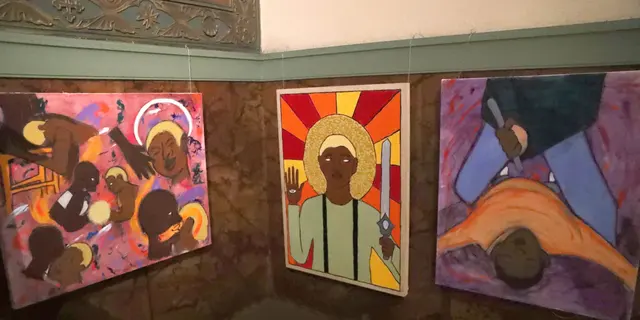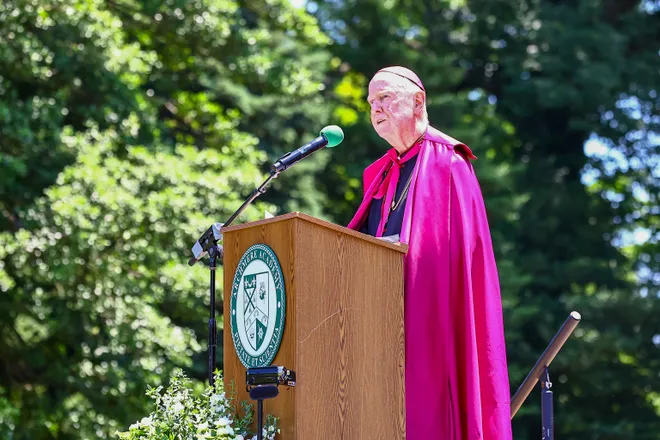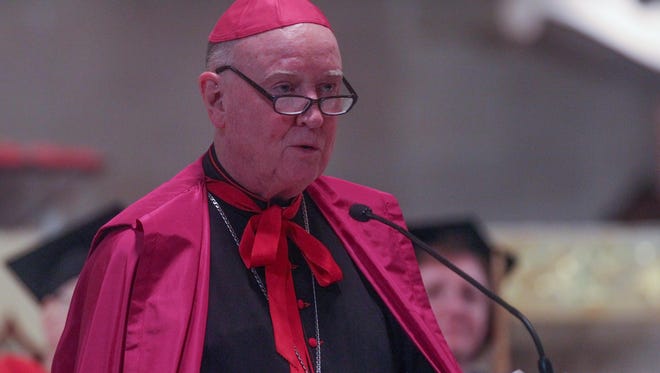There were fights when she drove her son to classes for his first Communion. He begged her not to leave him. The family felt unsettled by a Christmas letter from the priest they hardly knew.
“At the end of the letter, he said, ‘How is my sweet little [boy],’ and there, I felt really nauseous for some reason. It’s like someone punched me in the stomach,” the mother would tell attorneys in a deposition. “I told my husband. I said, ‘Look at this letter. It doesn’t sound right to me.’ ”
They would later learn what troubled their son. He alleged in a 2018 federal lawsuit in their home state of Georgia that he had been made to perform a sexual act on the Rev. John Peter Krzyzanski — “or he would not get into heaven.”
But someone reading the report won’t find his name. He’s anonymous, just listed as “#151.”
Krzyzanski is one of 10 living church figures accused of abuse whose identities are redacted from the report. The names were hidden because they surfaced during the confidential grand jury investigation that produced the report — not because of doubts about the credibility of the allegations.
To identify them, reporters matched details in the report to court transcripts, archdiocesan letters, church directories, news articles and other public documents. The family in suburban Atlanta requested anonymity. The Banner does not identify victims of sexual abuse without their consent. In addition to Krzyzanski, the other priests are:
- The Rev. Samuel Lupico (No. 152)
- The Rev. Joseph O’Meara (No. 155)
An archdiocesan spokesperson cited the confidentiality order of the court in declining to confirm or refute the three names. The attorney general’s office declined to comment for this article.
Survivors of clergy sexual abuse want all 10 alleged abusers to be named. Otherwise, the report mostly repeats or expands on known allegations and names deceased priests.
The Baltimore judge who ordered the report’s release called it a public reckoning. But to survivors, any reckoning falls short while church officials and clergy benefit from anonymity.
In other states, clergy whose names were redacted from similar reports fought to keep their identities hidden and often won. That’s led survivors, advocates and journalists to work to reveal the names hidden in the Maryland report. Also redacted are names of five church officials who handled allegations of abuse.
“Official C” has been identified as as W. Francis Malooly, the retired bishop of the Diocese of Wilmington. That identification was made last month by Terry McKiernan, the founder of BishopAccountability.org, a Massachusetts nonprofit that collects documents related to clergy sexual abuse cases.
Malooly retired in 2021 as bishop of Wilmington and previously served as auxiliary bishop of Baltimore. The report shows Malooly handled allegations of abuse in Baltimore for roughly two decades and failed to report some cases to authorities.
The Baltimore Sun also identified Malooly and four additional redacted church officials on Thursday.
“The names need to come out,” McKiernan said. “Survivors are very, very unhappy about these redactions and understandably so. They’re giving something with one hand, and it’s taken away with another.”
‘More concerned with avoiding scandal’
The attorney general’s report mentions “Official C,” or Malooly, more than 70 times when discussing the conduct of Baltimore church leaders who were confronted with allegations of abuse. No other redacted church leader’s name appears as often.
Malooly was a key figure in a leadership who is sometimes faulted in the investigation for ignoring the abuse even when survivors came forward. He helped handle 25 different clergy members’ abuse cases from 1985 to 2006.
“Church documents reveal with disturbing clarity that the Archdiocese was more concerned with avoiding scandal and negative publicity than it was with protecting children,” wrote investigators for the attorney general.
For example, there’s the case of the Rev. John Banko. A man reported in 1992 that Banko had abused him at St. Mary’s Seminary in Baltimore. Investigators say there is no evidence that Malooly took action to contact the survivor, investigate or report the allegation to police.
Instead, Malooly alerted Archbishop William Keeler so he could tell the bishop of Metuchen in New Jersey, where Banko worked at the time. Banko was later convicted of sexually abusing two teenage boys from his New Jersey parish and sentenced to 18 years in prison. Banko was listed as credibly accused by the archdiocese in 2002.
Scattered through the report are examples of Malooly’s failure to appropriately handle abuse cases. The Rev. Brian Cox told the attorney general’s office that he confided in Malooly about struggling with pedophilia. Cox said Malooly told him, “You’re a fine priest. Don’t worry about it.”
In another case, Malooly wrote a letter to accused abuser the Rev. Joseph Maskell in 1996 expressing satisfaction that a lawsuit filed against him might not proceed because the statute of limitations had expired.
The archdiocese moved Maskell from one parish to another after parents reported his inappropriate behavior with children. He ended up at the all-girls Archbishop Keough High School. At least 39 people have reported that they or others they know were sexually abused by Maskell, according to the report. He was placed on administrative leave and resigned in 1994, before moving to Ireland.
Another case shows Malooly’s steps to protect the church’s reputation. The Rev. James Toulas at Our Lady of Fatima Parish in East Baltimore was placed on administrative leave in 1993 and sent to counseling following allegations that he had repeatedly groped a 14-year-old boy, according to the report.
Malooly sent a letter to Toulas saying the action was taken due to “the nature of the accusations” and “the clear possibility of public scandal.” Malooly encouraged him to get counseling: “With your religious superiors, we stand ready to assist you in any way we can during this time.”
The report said Toulas admitted the abuse. He was placed on the list of credibly accused priests in 2022.
As bishop of Wilmington, which includes the Eastern Shore of Maryland, Malooly shepherded the diocese through its bankruptcy over clergy abuse. Malooly wrote online about the chance for a fresh start when the diocese emerged two years later from reorganization.
“But we must never forget or gloss over the suffering endured by survivors of abuse,” he wrote.
His open letter was required by the bankruptcy settlement.
Malooly did not reply to phone calls, an email or a registered letter requesting comment.
‘He always had a 35-millimeter camera strapped around his neck’
Krzyzanski served as a Franciscan friar for four decades in the Our Lady of the Angels Province, which has locations in 11 states and headquarters in Ellicott City. He told the court he was assigned to the St. Joseph Cupertino Friary in Ellicott City from 2001 to 2011.
The attorney general’s report does not accuse Krzyzanski of sexual contact with children. The lawsuit accuses him of two sexual acts against the 6-year-old boy two decades ago in suburban Atlanta.
Also in Georgia, Krzyzanski’s superiors found him with downloaded child pornography and sent him in 2000 for psychiatric treatment at the St. Luke Institute in Maryland, according to the report. Investigators wrote that he also took thousands of pictures of young girls and displayed them around his room, though his superiors did not consider the photos erotic.
“He always had a 35-millimeter camera strapped around his neck,” the boy’s father recalled in a deposition for the lawsuit.
Krzyzanski underwent three psychiatric evaluations over the years, and he admitted to viewing child pornography and feeling attracted to girls as young as 11, according to the report. He denied sexual contact with children.
One psychiatrist found insufficient evidence to diagnose him with pedophilia and concluded that there was no reason to believe he would act in a sexual manner with a child, according to the report. But going forward, the psychiatrist recommended he minister to adults only.
Krzyzanski submitted that evaluation to the Archdiocese of Baltimore in 2006 in hopes of getting a new assignment. Investigators wrote that there’s no indication the archdiocese granted him one.
The lawsuit was filed against him more than a decade later after he had moved to a home for senior friars near Albany, New York. Krzyzanski denied the allegations in the lawsuit.
In his deposition, Krzyzanski told attorneys he had only passing contact with the family and no one-on-one contact with their son.
The case went on for three years before a judge dismissed the lawsuit on procedural grounds. The survivor appealed and settled with Krzyzanski out of court almost one year later. Joseph Michael Todd, the survivor’s attorney, said he was unable to comment because of a confidentiality agreement.
Reached by phone, Krzyzanski was told he’d been identified as #151. He did not deny or confirm this, but said he believed the report to be redacted and asked how he had been identified.
Any information included in the report about him had been provided without his consent, Krzyzanski said, and he was working with an attorney. He declined to name the attorney.
Krzyzanski said he did not expect a call from a reporter and hung up.
Alcohol and alleged sexual advances
The Rev. Samuel Lupico came to Maryland as a priest in the 1970s and served for decades within the Archdiocese of Baltimore. He also taught courses at Loyola University of Maryland, according to archdiocesan records.
In 2014, a man reported that Lupico gave him alcohol, provided back rubs while aroused and made sexual advances in the 1980s, according to the report, which refers to Lupico as No. 152. The man described himself as Lupico’s foster son. He said that he lived in the rectory with the priest and was not “molested.”
When the archdiocese interviewed him, Lupico admitted that two teens lived in his house for a few months.
In 2021, a man reported that Lupico groped him when he was 12 or 13 in the mid-1970s, according to the report. And last year, the archdiocese announced it was investigating an allegation of child sexual abuse involving Lupico from the mid-1970s, when he served at St. Ann’s Catholic Church in East Baltimore.
Church officials wrote that Lupico had retired and been assisting at St. Mary of the Assumption in Northeast Baltimore and St. Pius X in Rodgers Forge. They removed his duties as a priest and suspended him during an investigation.
An archdiocesan spokesperson did not respond to recent questions about the status of that investigation.
Lupico denied the allegation, according to the archdiocese.
When a reporter called Lupico about the report, he said, “I don’t want to talk about that,” before hanging up.
Kojo Quartey, for one, called Lupico a mentor. The president of Monroe County Community College near Detroit, Quartey said in an interview he was essentially homeless with nowhere to go while attending Morgan State University. Then Lupico allowed him to stay for free in the rectory at St. Ann’s Catholic Church from 1979 to 1981.
”I’m not privy to any malfeasance or any occurrences of a sexual nature,” Quartey said. “None of that occurred with me.”
‘Avoiding him and fending him off’
The Rev. Joseph O’Meara began as a deacon in the archdiocese and served for decades in Maryland before retiring in 2010.
One woman described how O’Meara, identified in the report as No. 155, would kiss her mother and girls on the mouth. O’Meara, she said, visited her home regularly, made her sit on his lap and came in the bathroom while she was in the shower, according to the report.
A second woman said she and her sisters felt uncomfortable when O’Meara would kiss children on the mouth, investigators wrote.
And yet another woman said O’Meara often had dinner at her home in the early 1980s and would sometimes try to slide his hand up her leg toward her genitals under the table. She was 7 at the time. He stopped touching her when she entered high school, according to the report.
“She discussed him with her friends in the community and two of her friends described the same behavior,” investigators wrote. “They all discussed methods of avoiding him and fending him off.”
While a priest, O’Meara fired a housekeeper in 2000 who said he behaved inappropriately and talked about the size of her breasts, according to the report.
Then three women reported that O’Meara inappropriately touched them, according to a letter sent to church parishioners in 2019. The report describes similar allegations, detailing how three women in 2020 reported that O’Meara touched their breasts as adults.
The archdiocese announced that it had removed O’Meara from ministry and that he would no longer live at the St. Agnes and St. William of York parishes in Southwest Baltimore.
He was sent for an evaluation at the St. John Vianney Center, a Catholic behavioral health and addiction treatment facility west of Philadelphia, but left against the advice of the archdiocese, according to the report.
O’Meara could not be reached for comment. He did not respond to voicemails or text messages.
Will anyone identify the rest?
Before adding a name, the archdiocese investigates and determines whether the allegation is credible. If so, church leaders present their findings to an eight-member independent review board for a vote.
University of Maryland Chancellor Jay Perman heads the interfaith board of lay people, with representatives from the legal community, law enforcement, health care, academia and social work. Board members have met twice this year, but church leaders have not provided them the redacted names for consideration.
Maryland history shows abusers continued their misconduct amid the silence of church leaders and favor from authorities. The 10 anonymous clergy members are presumed alive and not widely known to be accused of wrongdoing.
The attorney general’s office said it redacted the names to head off any argument that the full report should not be released. Brown said his office will return to court and argue for permission to publish the names.
Now, the archdiocese has taken a position that it’s bound by the court from releasing the names. The attorney general disputes that position.
The rest of the names, for now, remain hidden.
Complete Article ↪HERE↩!







